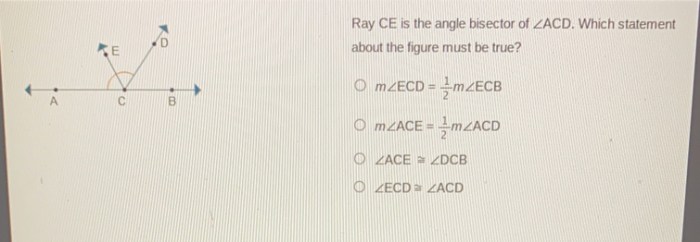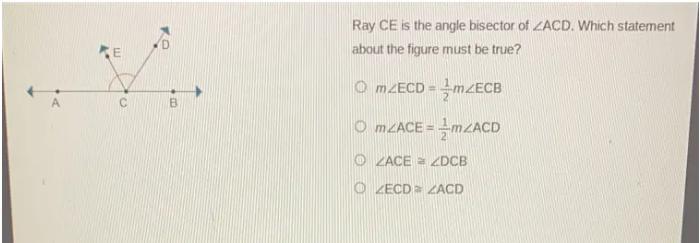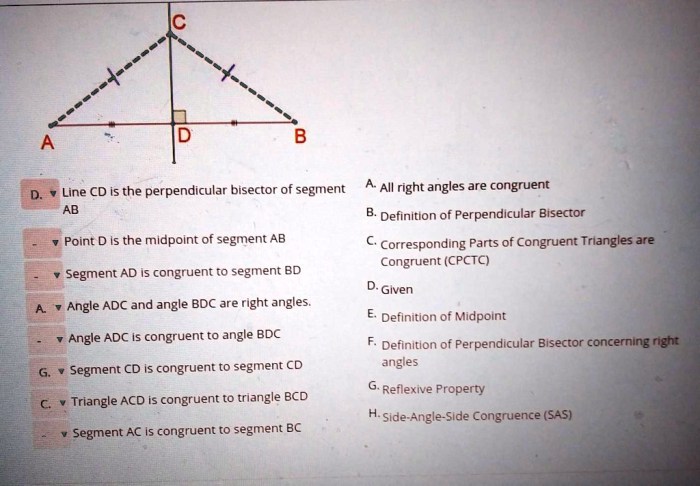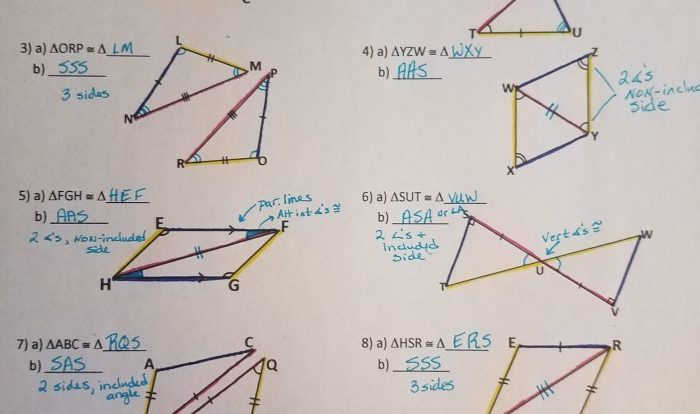Ray ce is the angle bisector of acd – In the realm of geometry, angle bisectors play a pivotal role, and ray CE stands out as the angle bisector of angle ACD. This concept holds profound significance, offering insights into geometric constructions, applications, and relationships with other geometric entities.
Angle bisectors possess unique properties, dividing angles into two congruent parts. Ray CE, as the angle bisector of angle ACD, embodies these properties, creating two equal angles adjacent to angle ACD.
Definition and Introduction: Ray Ce Is The Angle Bisector Of Acd

In geometry, an angle bisector is a ray or line that divides an angle into two equal parts. It plays a crucial role in geometry, as it helps in constructing perpendicular lines, finding the center of a circle, and solving various geometric problems.
The statement “ray ce is the angle bisector of acd” means that the ray ce divides the angle acd into two equal angles, ∠ace and ∠ecd.
Properties of Angle Bisectors
- An angle bisector divides an angle into two congruent angles.
- In a triangle, the angle bisector of an angle is also the perpendicular bisector of the opposite side.
- The angle bisectors of a triangle intersect at a point called the incenter, which is equidistant from all three sides of the triangle.
Properties of Angle Bisectors

Angle bisectors are line segments or rays that divide an angle into two equal parts. They possess several notable properties that are crucial in understanding their behavior and applications.
Angle Bisector Theorem
One of the fundamental properties of angle bisectors is the Angle Bisector Theorem, which states that if a ray bisects an angle, it divides the opposite side into two segments that are proportional to the lengths of the adjacent sides.
In other words, if ray CE bisects angle ACD, then:
AE/EC = AD/DC
Construction of Angle Bisectors

Constructing angle bisectors is a fundamental geometric skill that finds applications in various fields, including architecture, engineering, and design. By accurately dividing an angle into two equal parts, angle bisectors provide a precise and efficient way to create symmetrical structures and solve geometric problems.
Step-by-Step Construction Using Compass and Straightedge
The construction of an angle bisector using a compass and straightedge involves the following steps:
- Center the compass at the vertex of the angle.
- Draw two arcs intersecting both sides of the angle.
- Center the compass at each intersection point and draw two arcs intersecting inside the angle.
- Connect the point of intersection of the two arcs to the vertex.
The line segment drawn in step 4 is the angle bisector, dividing the angle into two equal parts.
Demonstration for Ray ce is the Angle Bisector of acd
To construct the angle bisector of angle acd, follow the steps Artikeld above:
- Center the compass at point c, the vertex of angle acd.
- Draw two arcs intersecting sides ac and cd.
- Center the compass at each intersection point (say, e and f) and draw two arcs intersecting inside angle acd.
- Connect the point of intersection of these two arcs (say, point g) to point c.
The line segment cg is the angle bisector of angle acd, dividing it into two equal parts, angles acg and gdc.
Applications of Angle Bisectors

Angle bisectors have numerous practical applications in geometry, such as finding the center of a circle or dividing a line segment into equal parts.
Finding the Center of a Circle
Given a circle, its center can be found by constructing the angle bisectors of any two chords. The point of intersection of these angle bisectors is the center of the circle.
Dividing a Line Segment into Equal Parts
To divide a line segment into equal parts, construct the angle bisector of the angle formed by the line segment. The point of intersection of the angle bisector and the line segment divides the segment into two equal parts.
Relationship to Other Geometric Concepts

Angle bisectors are closely related to several other geometric concepts, including perpendicular bisectors, medians, and altitudes. These relationships can be used to solve geometry problems involving angle bisectors.
Perpendicular Bisectors
The perpendicular bisector of a line segment is a line that passes through the midpoint of the segment and is perpendicular to it. If an angle bisector intersects a side of a triangle at a point other than the midpoint, then it must be the perpendicular bisector of that side.
Medians
A median of a triangle is a line segment that connects a vertex to the midpoint of the opposite side. If an angle bisector intersects a median at a point other than the vertex or the midpoint, then it must be parallel to the opposite side of the triangle.
Altitudes
An altitude of a triangle is a line segment that passes through a vertex and is perpendicular to the opposite side. If an angle bisector intersects an altitude at a point other than the vertex or the base of the triangle, then it must be parallel to the opposite side of the triangle.
Question & Answer Hub
What is an angle bisector?
An angle bisector is a ray or line segment that divides an angle into two equal parts.
How can I construct an angle bisector?
To construct an angle bisector using a compass and straightedge, follow these steps: Place the compass point at the vertex of the angle, and draw two arcs intersecting the sides of the angle. Connect the two points of intersection with a straightedge to form the angle bisector.
What are the applications of angle bisectors?
Angle bisectors have various applications in geometry, including finding the center of a circle, dividing a line segment into equal parts, and constructing perpendicular lines.

